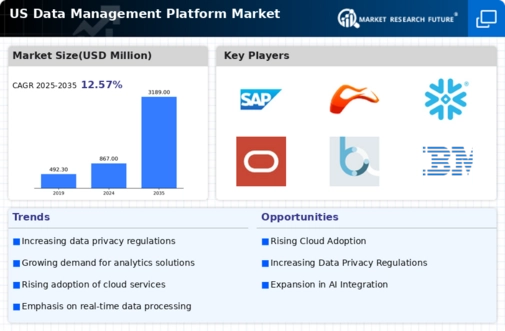Emphasis on Data Security and Compliance
In the current landscape, the data management-platform market is increasingly influenced by the heightened focus on data security and regulatory compliance. With the proliferation of data breaches and stringent regulations such as the CCPA and GDPR, organizations are compelled to adopt robust data management solutions that ensure data integrity and security. This emphasis on compliance is driving investments in platforms that offer advanced security features, including encryption and access controls. It is estimated that organizations are allocating upwards of 30% of their IT budgets to enhance data security measures, reflecting the critical importance of safeguarding sensitive information in the data management-platform market.
Rising Demand for Real-Time Data Processing
The data management-platform market is experiencing a notable surge in demand for real-time data processing capabilities. Organizations are increasingly recognizing the necessity of accessing and analyzing data instantaneously to make informed decisions. This trend is particularly pronounced in sectors such as finance and e-commerce, where timely insights can significantly impact operational efficiency and customer satisfaction. According to recent estimates, the market for real-time data processing solutions is projected to grow at a CAGR of approximately 25% over the next five years. This growth is indicative of a broader shift towards data-driven decision-making, compelling businesses to invest in advanced data management platforms that can handle high-velocity data streams effectively.
Increased Focus on Data Quality and Integrity
The data management-platform market is increasingly characterized by a focus on data quality and integrity. Organizations are recognizing that high-quality data is essential for effective decision-making and operational success. As a result, there is a growing demand for platforms that provide comprehensive data cleansing, validation, and enrichment capabilities. This trend is particularly relevant in sectors such as healthcare and finance, where data accuracy is paramount. Research indicates that poor data quality can cost organizations up to 20% of their revenue, prompting businesses to invest in data management solutions that ensure data integrity. This emphasis on quality is likely to shape the future landscape of the data management-platform market.
Expansion of Internet of Things (IoT) Applications
The proliferation of Internet of Things (IoT) devices is significantly impacting the data management-platform market. As more devices become interconnected, the volume of data generated is escalating rapidly, necessitating sophisticated data management solutions to handle this influx. Industries such as manufacturing, healthcare, and smart cities are particularly affected, as they rely on real-time data from IoT devices to optimize operations and improve service delivery. It is estimated that the number of connected IoT devices will exceed 30 billion by 2025, creating a substantial demand for data management platforms capable of processing and analyzing large volumes of data efficiently. This trend highlights the critical role of data management in harnessing the potential of IoT.
Growth of Artificial Intelligence and Machine Learning
The integration of artificial intelligence (AI) and machine learning (ML) technologies is transforming the data management-platform market. These technologies enable organizations to automate data processing tasks, enhance predictive analytics, and derive actionable insights from vast datasets. As businesses increasingly seek to leverage AI and ML for competitive advantage, the demand for data management platforms that support these technologies is expected to rise. Analysts project that the AI-driven data management market could reach a valuation of $10 billion by 2027, indicating a robust growth trajectory. This trend underscores the necessity for data management solutions that can seamlessly integrate with AI and ML tools, thereby enhancing overall data utility.























Leave a Comment